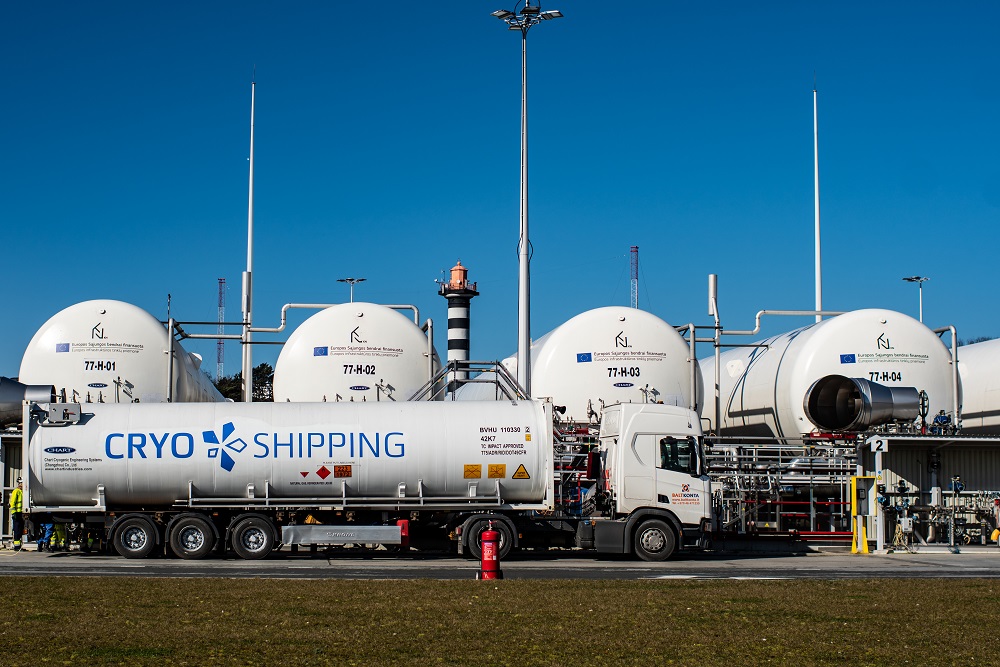A vessel filled with LNG for the first time in Klaipeda Port
.jpg) On March 8, a liquefied natural gas (LNG) powered vessel was successfully bunkered for the first time in the port of Klaipėda. During this operation, the fuel tank of the cement carrier MV Greenland was filled with gas at the Malkos Bay Terminal.
On March 8, a liquefied natural gas (LNG) powered vessel was successfully bunkered for the first time in the port of Klaipėda. During this operation, the fuel tank of the cement carrier MV Greenland was filled with gas at the Malkos Bay Terminal.
In the first LNG bunkering operation, as many as four different parties worked together – KN (Klaipėdos Nafta, AB), the Norwegian company Cryo Shipping AS, Ignitis UAB and Baltkonta UAB, thus contributing to less shipping pollution and increasingly noticeable positive developments in the sector.
Cryo Shipping has brought to Klaipeda the cleanest fossil LNG fuel filled intermodal ISO container, which can be mounted on both the train platform and the truck. This time, the LNG-filled ISO container was hoisted onto a Baltkonta truck and transported to the Malkos Bay Terminal. The first bunkering operation from the ISO container to the cement carrier in Klaipėda Port was carried out by Cryo Shipping AS, an LNG bunker supplier with roots from shipping providing safe, customer-oriented and customer-adapted LNG bunkering solutions for the shipping industry.
Forty five cubic meters of LNG were loaded from the ISO container mounted on the truck to the fuel tank of MV Greenland cement tanker. The bunkering operation was conducted in accordance with all good practice requirements and recommendations of the European Maritime Safety Agency.
Following the bunkering of the ship, the ISO container of LNG, purchased by Cryo Shipping from UAB Ignitis, was filled up at land-based LNG reloading station operated by KN. MV Greenland cement tanker will be bunkered in Klaipeda in March.
Nicholai H. Olsen, Director of Cryo Shipping AS, says that Klaipeda was chosen for cement tanker bunkering because of the KN LNG reloading station infrastructure in this port. According to him, the breakthrough in the field of LNG bunkering in Klaipeda Port was due to the rallying and cooperation of all partners.
“We are very grateful for all the help we have received from all the parties involved in this operation. Going forward we believe Klaipeda will be an important LNG bunker port, and CRYO Shipping will support and promote Klaipeda to become a key LNG bunker port in the Baltic”, he said.
Nicholai further explains that CRYO Shipping will charter an LNG bunker vessel for their operations introducing Ship-To-Ship LNG bunkering for their clients, and CRYO Shipping would be very glad to operate the LNG bunker vessel in Port of Klaipeda as well.
Darius Šilenskis, CEO of KN, says that the process was complicated by the lack of current legislation regarding the regulation of LNG bunkering in Lithuania.
“The initial document regulating LNG bunkering in the port will be the Port Shipping Regulations, which are being revised by the entire community interested in the LNG bunkering,” D. Šilenskis says. “Until these are in place Cryo Shipping AS had to go a long way in obtaining permission for the first LNG bunkering operation in the port of Klaipėda and to negotiate a series of documents, defining a safe operation, and securing the permission of the Harbor Master’s Office in this particular case at Klaipėda Port”.
Kęstutis Kairys, Head of Baltkonta UAB, notes that the first bunkering operation in Klaipeda is very good news for market participants and a major step forward in the field of LNG.
“I remember that two years ago we were just considering bunkering a ship from a tank truck. Today, this opportunity has become a reality and I have no doubt that this message will reach many shipowners who will discover Klaipeda as an LNG bunkering port”, says K. Kairys.
Several LNG-powered ships visited Klaipėda State Seaport in 2019. These include LNG-powered vessels of the following companies: Unifeeder (Wes Amelie), Containerships (Nord, Aurora, Polar), Furetank (Fure Ven, Fure West, Ramanda), Norlines (Kvitbjorn). Individual visits to the port of Klaipėda of LNG-powered vessels from other companies are noticed as well. It should be noted that until now, LNG-powered vessels only came to the port of Klaipėda for transshipping rather than LNG bunkering, i.e. not for the purpose of filling vessel’s fuel tanks with LNG as a fuel.
 This weekend’s LNG bunkering operation at the Port of Klaipėda is the first one so far.
This weekend’s LNG bunkering operation at the Port of Klaipėda is the first one so far.
However, D. Šilenskis says that based on the number of LNG-powered vessels and the growing number of their orders in the Baltic and North Seas, the number of LNG bunkering operations will increase.
According to consulting and classification Company DNV GL, there are 177 LNG-powered vessels worldwide and by 2027, another 208 marine vehicles using this type of fuel will be built. The highest concentration of such vessels is currently recorded in the North and Baltic Seas.
“The emergence of new LNG transportation and bunkering vessels increases the competitiveness and availability of the region’s LNG market as well as allows to utilise the LNG infrastructure created in Klaipėda more efficiently,” D. Šilenskis says.
LNG-powered vessels coming to Klaipėda port can be bunkered in three different ways: at various port loading terminals from LNG tank vehicle to ship, from terminal to ship in a custom KN operated LNG reloading station, and from ship to ship. Although Klaipėda currently has no permanently residing LNG bunkering vessel, LNG transportation and bunkering services are provided in the Baltic and North Sea region by a number of available vessels.


